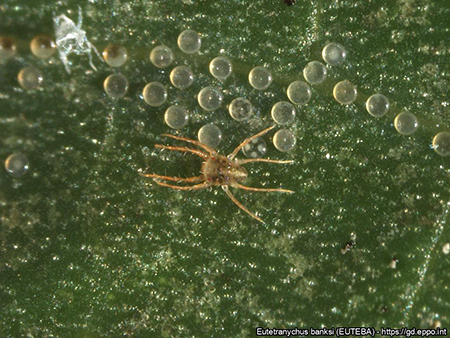
EPPO Alert List – Eutetranychus banksi (Acari: Tetranychidae)
Texas citrus mite
Why
Eutetranychus banksi (Acari: Tetranychidae – Texas citrus mite) is a polyphagous species which has been present in Portugal on citrus since 1999. It has spread within the Iberian Peninsula (Portugal and Spain) and become more damaging in recent years, becoming the most common and abundant spider mite on citrus there. The EPPO Secretariat considered it useful to add it to the Alert List to raise awareness of other Southern EPPO countries.

Eutetranychus banksi male and eggs
Courtesy: Francisco José Ferragut Pérez
(Universitat Politècnica de Valencia)

Damaged fruit (bottom) compared to healthy fruit (top)
Courtesy: Francisco José Ferragut Pérez
(Universitat Politècnica de Valencia)

Damage on leaves
Courtesy: Francisco José Ferragut Pérez
(Universitat Politècnica de Valencia)
Where
E. banksi is widely distributed in North, Central and South America. It was first recorded in Europe in 1999 but remained in a restricted area up to 2013. It was recently found in Madeira (2020) and in India (2021).
EPPO Region: Portugal (mainland, Madeira), Spain (mainland).
Asia: India (Uttar Pradesh).
North America: Mexico, United States of America (Arizona, California, Florida, Hawaii, Texas).
Central America and Caribbean: Costa Rica, Cuba, Dominican Republic, El Salvador, Guadeloupe, Guatemala, Honduras, Martinique, Nicaragua, Panama.
South America: Argentina, Brazil (Bahia, Ceara, Distrito Federal, Goias, Mato Grosso, Minas Gerais, Pernambuco, Rio Grande do Sul, Sao Paulo), Colombia, Ecuador, Paraguay, Peru, Uruguay, Venezuela.
On which plants
E. banksi is a very polyphagous species, known to be able to develop on over 100 species from over 30 families with a preference for Fabaceae and Rutaceae. It has been recorded as causing economic damage on citrus.
Damage
E. banksi feeds by consuming the contents of mesophyll plant cells, reducing the leaf’s photosynthetic capacity, and promoting defoliation, which may result in a decrease in yield. In addition, it may cause aesthetic damage to the fruits (e.g. on citrus), resulting in a lack of pigmentation, which reduce their economic value. E. banksi is very similar morphologically to Eutetranychus orientalis (Acari: Tetranychidae – EPPO A2 List) and also lives on the upper side of leaves.
Control relies mainly on acaricides and biocontrol. However, native biological control agents efficient against other mites such as Panonychus citri are not very efficient against E. banski. E. banski is more resistant to high temperatures than P. citri and E. orientalis.
Dissemination
Spider mites mainly disperse by wind currents. In international trade, they might be carried on host plants. It has been suggested that E. banksi spread from Portugal to Spain via contaminated fruit containers.
Pathways
Plants for planting, cut foliage, fruit?, fruit containers?
Possible risks
E. banksi is a very polyphagous species, causing economic damage in citrus production. It has already established in parts of the EPPO region and may carry on spreading. As it is very polyphagous, it could also cause damage in other crops.
Sources
Ferragut F, Navia D, Ochoa R (2013) New mite invasions in citrus in the early years of the 21st century. Experimental and Applied Acarology 59, 145-164.
López-Olmos S, Ferragut F (2023) The newcomer takes it all: the invader Texas citrus mite, Eutetranychus banksi (Acari: Tetranychidae), displaces the resident relatives in citrus agrosystems. Biological Invasions 25, 3171–3192. https://doi.org/10.1007/s10530-023-03099-z
Migeon A & Dorkeld F (2024) Spider Mites Web: a comprehensive database for the Tetranychidae. Available from https://www1.montpellier.inrae.fr/CBGP/spmweb (Accessed 2024/04/23)
Naves P, Aguiar AF, Santosa M, Nóbrega F, Varela AR, Silvaa MJ, Migeon A, Navia D, Auger P (2023) Two new alien Eutetranychus mites (Prostigmata, Tetranychidae) for Madeira Island, Portugal. Acarologia 63(4), 1154-1162. https://doi.org/10.24349/t82c-9sz9
Yadav RS, Painkra GP, Kerketta D, Kumar D, Raghuraman M (2021) First record of Texas citrus mite, Eutetranychus banksi (McGregor) infesting neem (Azadirachta indica A. Juss) from India. Journal of Entomological Research 45(suppl), 1098-1102.
EPPO RS 2024/086
